THE BEAUTIFUL RENAISSANCE CITY OF FERRARA
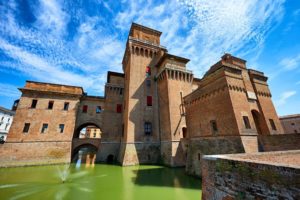
The north of Italy has an abundance of riches for the visitor, and it’s almost impossible to make a list of top favourites. There’s the sublime beauty of the various lakes, the glories of Venice, and numerous small Renaissance cities to choose from. We’ve spent many wonderful trips exploring these Renaissance gems over decades, and they all have their own unique character and attractions. Recently, we re-visited the beautiful city of Ferrara, a little over 110 kms south of Venice. We hadn’t been there for years, and thought another visit was well overdue.
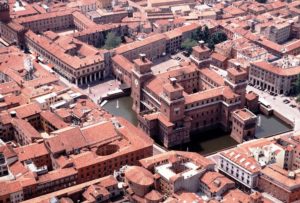
We took a train from Venice down to Ferrara, a quick, relaxing trip that only took an hour. Ferrara is such a walkable city, with most of its many attractions within easy walking distance from the centre. As we were hiring a car at the end of our stay, we could stay close to the centre without having to worry about where to park a car, or if our hotel had on-site parking.
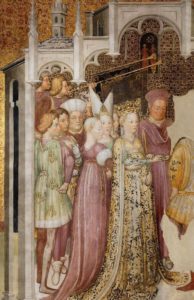
The history of this region is one of intrigue, romance and drama—and Ferrara has had more than its share of all that! Although the origins of Ferrara are unknown, the ruins of an Etruscan settlement have been found nearby at the ancient mouth of the river Po. A town, thought to be Ferrara, was mentioned in the documents of a Lombard king named Desiderius in 754AD, where it’s implied that the foundation of the town dated back to the previous century. Shortly after, the Lombards were routed by the Franks who presented Ferrara to the Papacy. From then on, Ferrara was governed by a series of Counts, about whom little is known. In the early 12th century, an influential Bishop succeeded in undermining the Archbishop of Ravenna and took control. Ferrara developed rapidly and also became rich, thanks to its control of the navigation on the nearby Po River.

In 1167, Ferrara was a founding member of the Lombard League, but there was constant in-fighting between the various alliances in the League, until the powerful Este family stepped in. They already had interests in the growing town, and after battling various other families and factions, finally became Lords of the city and set up their court in 1264 when Obizzo ll d’Este was proclaimed lifelong ruler of Ferrara. He took the additional titles of Lord of Modena in 1288 and of Reggio in 1289. Despite periods of crises that still occurred, the Este court shone in the fields of diplomacy, while the arts, politics and culture flourished, especially renowned for its architecture, music, literature and visual arts. The city was eventually transformed into one of the most important European centres, which continued throughout the 15th and 16th centuries. The Este rule lasted until 1598.
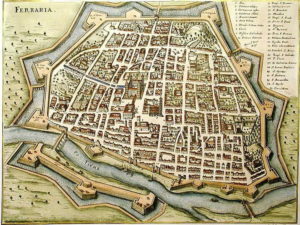
Under Ercole l, the architecture of Ferrara greatly benefited from the genius of Biagio Rossetti, from whom Ercole commissioned a masterplan for the expansion of the town in 1484. The resulting “Erculean Addition” is considered one of the most important examples of Renaissance urban planning, and contributed to the designation of Ferrara as a UNESCO World Heritage Site in 1995. The World Heritage listing was later expanded in 1999 to include the very fertile region between the city and the eastern coastline of Italy.
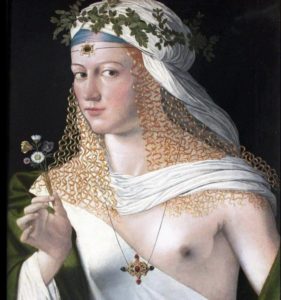
In spite of having entered its golden age, Ferrara was severely hit by wars back and forth with Venice and yet more internal upheavals. One ruler, Alfonso I married the infamous Lucrezia Borgia, fought Venice again in the Italian Wars, was excommunicated by the Pope, but went on to defeat both Papal and Spanish armies. These successes were largely attributed to Ferrara’s artillery, produced in the local foundry which was the best of its time.
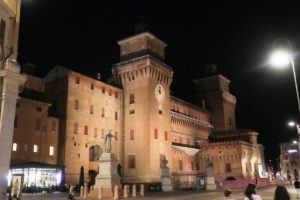
The most notorious Este was Nicolò lll, who became head of the family in 1393 at the age of 10. Married at just 14, marital fidelity was not his style, and he is said to have kept an astonishing 800 mistresses. Around 30 of his children were brought up in a somewhat ramshackle manner in Castello Estense. Despite his cheerful appearance, he had a controlling disposition and vile temper. He caught his beautiful wife in the arms of her stepson Ugo, and had them both brutally beheaded in the dungeons of the Castello. This gruesome tale was famously immortalised by Lord Byron in the poem Parisina, which was followed by operas of the same name by Donizetti and Mascagni.
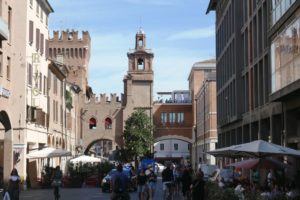
Another ruler, Ercole ll, married a daughter of Louis Xll of France, bringing great prestige to Ferrara. Under his reign, the Duchy remained very affluent and a cultural powerhouse. However, an earthquake struck the town in 1570, causing the economy to collapse, and when Ercole ll’s son died without heirs, the House of Este lost Ferrara to the Papal States.
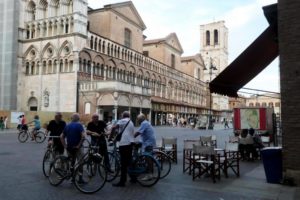
Ferrara, a university city second only to Bologna, remained a part of the Papal States for 300 years, an era marked by a steady decline in importance and also population. During the Napoleonic years, it was briefly a client state of the French empire. After Napoleon, Ferrara was returned to the Pope under the Congress of Vienna, and became an Austrian garrison town. Troops occupied the bastion fortress that had been erected in the 1600s by Pope Paul V on the site of an old castle, the Castel Tedaldo. This fortress was completely dismantled following the unification of the various Italian states to become the Kingdom of Italy, and the bricks used to construct new buildings throughout the town.
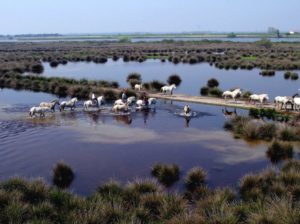
Until the early 1900s, Ferrara remained a modest trading centre for its crops such as sugar beet and industrial hemp. Large areas of swamp land were reclaimed to expand the available arable land and to eliminate malaria from the wetlands along the Po delta. Mass industrialisation came to Ferrara only at the end of the 1930s, when the Fascist regime set up a chemical factory to supply them with synthetic rubber. During WW2, Ferrara suffered repeated Allied bombing that destroyed railway links and industrial capabilities.
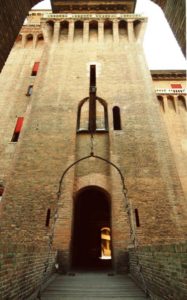
Ferrara’s landmark, the imposing Castello Estense, adjacent to the Corso Roma, today known as the Corso Martiri della Libertà, was the site of an infamous massacre in 1943 of mostly local Jews by Mussolini’s fascist troops.
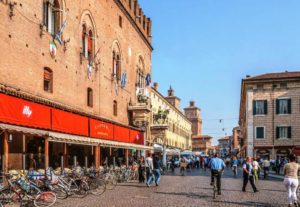
Nowadays, higher education and tourism are major sources of income for Ferrara.
The iconic image of Ferrara, and its most impressive historic building, is the massive Castello Estense (Este Castle) in the very centre of town. It’s an enormous red brick fortified manor house, constructed in 1385 featuring 4 massive bastions, and is still surrounded by a water-filled moat.
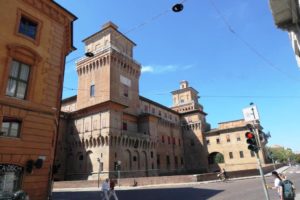
Its function was to protect the town from the many, and constant, external threats, and of course, to serve as a fortified residence for the Este family. Exploring the interior, including down into the prison cells, is very atmospheric, and there are some lovely, frescoed ceilings with classical scenes and a pretty little marble ducal chapel to visit.
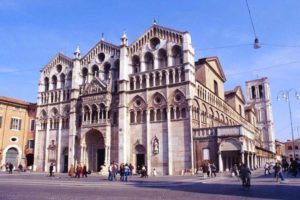
Also in the city centre is the Basilica Cattedrale di San Georgio, the Duomo di Ferrara. Consecrated in 1135, it’s one of the finest examples of Romanesque architecture in Italy. With some later alterations and additions, there are also considerable Gothic forms such as some peaked arches over the first gallery, while the interior was remade in Baroque style after a fire in the 18th century. This part of town is full of cafes, bars, restaurants, and busy little shops to wander around.
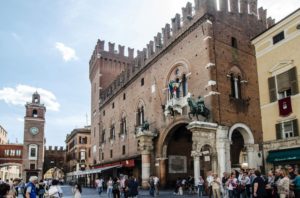
Near the cathedral and the Castello Estense lies the 15th century Palazzo Communale (Town Hall), which was once an earlier residence of the Este family. The southern area of the city is its oldest, with a myriad of little streets and alleys that date back to the early Middle Ages.
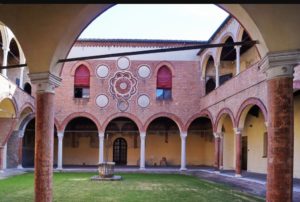
One of the best preserved monuments in the city is the Museo di Casa Romei in via Savonarola. Like most of the palazzi of Ferrara, this was built during the Renaissance for the Este family and members of the court between the 15th – 16th centuries. It has a lovely internal courtyard, and an impressive interior, with frescos that have come from a number of the city’s churches, a number of gravestones, statues and architectural decorative items from various Ferrara mansions.
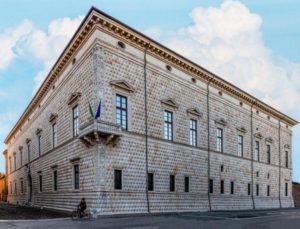
Another landmark building in Ferrara is the Palazzo dei Diamanti, a Renaissance palace located a few streets away from the centre. Built in 1492 by Ercole l d’Este, who demolished the walls of the northern end of the city to make way for it. It was used as a residential home until 1832 when it was acquired by the municipality of Ferrara to house the Pinacoteca Nazionale (National Gallery of Art) and the Civic University. Its most striking feature is the bugnato of the exterior walls. These are pyramidal white marble blocks veined with pink that have been carved to represent diamonds—hence its name. The positioning of the diamonds varies in order to maximise the light reflected off the building, creating quite a striking visual effect.
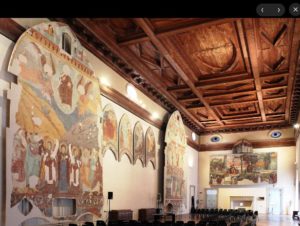
The art collection consists of notable works from 13th – 16th centuries, including artists such as Carpaccio and the Bellini family, while on the lower floor there is the Civic Gallery of Modern and Contemporary Art, with important works by Derain, Corot, Degas, Edvard Munch, Sisley and JMW Turner, to name just a few artists represented.
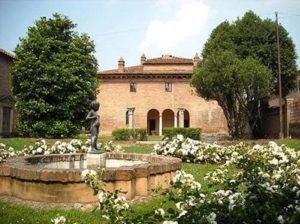
Ferrara has many more fine churches. Particularly make time to visit the richly decorated Santa Maria in Vado, which was said to be the site of a 12th century miracle, and its fine interior. There’s a long list of palaces and museums, including Palazzo Massari, which now houses the Museo Boldini, the Casa di Ludovico Ariosto, the house where the poet lived and died, that now contains a small museum; Palazzo Paradiso, which was formerly a university building and still contains an anatomy theatre, that’s now a library of rare manuscripts, and the Palazzina Marfisa d’Este, a one-storey building with important frescoes and antique furniture that once belonged to Francesco d’Este, and inherited by his daughter who was a great art patron.

Once a year, usually at the end of August, Ferrara holds a Festival dei Buskers, when the streets are filled with buskers of all kinds. In May there’s a Palio, the traditional horseback contest between the town’s districts preceded by processions in historic costumes.

Said to be the oldest Palio in the world, it was first held in Ferrara in 1259. There is an antiques market on the first weekend of every month, and on the 3rd weekend there’s a little craft market.
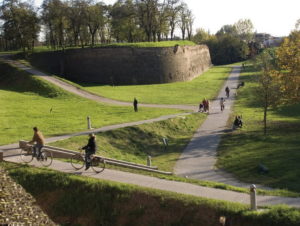
One of the things Ferrara is known for is its cycling paths, particularly the long route around the city walls where the active can cycle, jog or simply stroll. Only Lucca in Tuscany can claim a more complete set of walls than Ferrara. With a total circumference of 9 kms, Ferrara’s are longer and among the most impressive in Italy.
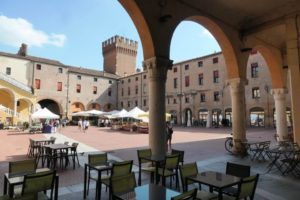
Ferrara was once a dangerous melting pot of influential families vying for power. Today, we see a beautiful town with a quiet air of prosperity, thanks to its university and many professional services, evidenced by the quality of its shops and restaurants, general amenities and well-maintained public domain, making it a perfect place to explore for a day or two.
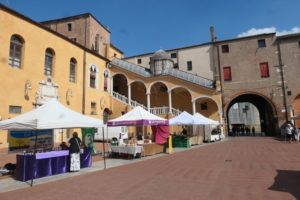


Thank you for such a detailed review of such a beautiful and interesting town ! I will definitely put this on my list of must see places to visit.
Hi Julie,
Ferrara is indeed a real gem. We’d been there many years ago, and had always meant to return. Somehow, so many other things got in the way, but we finally made it. After the craziness of Venice during Biennale (huge fun, but quite exhausting after a week or so), Ferrara was such a joy! All those northern Italian Renaissance cities/towns are lovely, each with its own individual charm and attractions. We certainly won’t leave it so long again for returning to Ferrara. So delighted you enjoyed the story, and yes, Ferrara is definitely worth a detour, as the saying goes. Do let me know if there’s anything else about it you’d like to ask. Cheers for now, Cheryl
What a very interesting area. Are you in Australia for Christmas this year?
Hi Tony and Annette,
How lovely to hear from you, and delighted you found the story of interest. We’d been to Ferrara decades ago, and like virtually all of those northern Italian small cities, it has so many attractions and on a very do-able scale. We’ve promised ourselves we won’t leave it so long for a another repeat visit. Yes, Graham and I will be here for Xmas, but heading off to “you know where” on 29 Dec., where we’ll spend a couple of weeks before flying down to Puglia in southern Italy for a few weeks. We touched on it many years ago, but only briefly, and have always wanted to return and explore it more fully. We’re back on 01 Feb. I wonder if we can fit in a catch up at our “usual” before we depart? If not, most definitely on our return. It has been far too long.